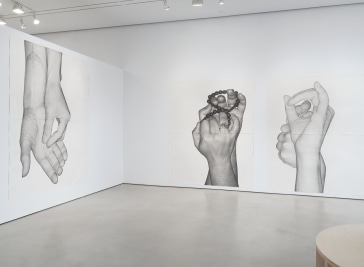
KARL HAENDEL
Lion 7
2020
Pencil and ink on paper
Two sheets, overall: 80 by 89 1/2 in. 203.2 by 227.3 cm.
KARL HAENDEL
Lion Cub 3
2020
Pencil and ink on paper
45 1/2 by 59 1/16 by 2 in. 115.6 by 150 by 5.1 cm.
KARL HAENDEL
Hazel's Hand (quadrupled)
2018
Pencil on paper
102 3/4 by 144 in. 261 by 365.8 cm.
KARL HAENDEL
Installation view of Masses & Mainstream at Mitchell-Innes & Nash, New York, 2019
KARL HAENDEL
Civil War General
2018
Pencil on paper
72 1/8 by 89 1/4 in. 183.2 by 226.7 cm.
KARL HAENDEL
Child King 3
2018
Pencil on paper
69 by 51 1/2 in. 175.3 by 130.8 cm.
KARL HAENDEL
E.T./E.T./Elizabeth Taylor
2018
Pencil on paper
52 1/2 by 87 3/4 in. 133.4 by 222.9 cm.
KARL HAENDEL
No Title (Ruth Roman/Jimmy Stewart/Ruth Roman)
2017
Pencil on paper
61 1/8 by 51 1/2 in. 155.3 by 130.8 cm.
KARL HAENDEL
1990's Phone
2017
Pencil on paper
22 5/8 by 30 1/8 in. 57.5 by 76.5 cm.
KARL HAENDEL
Minus Chardin #3
2017
Pencil on paper
30 1/8 by 22 5/8 in. 76.5 by 57.5 cm.
KARL HAENDEL
Power Cord #4
2017
Pencil on paper
30 1/8 by 22 5/8 in. 76.5 by 57.5 cm.
KARL HAENDEL
Cat
2017
Pencil on paper
30 1/8 by 22 5/8 in. 76.5 by 57.5 cm.
KARL HAENDEL
My Daughter Asked Me to Draw Her a Castle and then Wanted to Help
2017
Pencil on paper
22 5/8 by 30 1/8 in. 57.5 by 76.5 cm.
KARL HAENDEL
Rodeo 2
2016
Pencil on paper
104 by 82 1/2 in. 264.2 by 209.6 cm.
KARL HAENDEL
Organic Bedfellow, Feral Othello
Installation view at Mitchell-Innes & Nash, NY, 2015
KARL HAENDEL
Claire
2015
Pencil and enamel on paper
87 by 52 in. 221 by 132.1 cm.
MI&N 12687
KARL HAENDEL
Hindenburg
2015
Pencil on paper with shaped frame
89 1/2 by 86 in. 227.3 by 218.4 cm.
MI&N 12676
KARL HAENDEL
Durand
2015
Pencil on paper with shaped frame
39 1/2 by 64 in. 100.3 by 162.6 cm.
MI&N 12675
KARL HAENDEL
Knight #8
2011
Pencil on paper
103 by 79 1/2 in. 261.6 by 201.9 cm.
KARL HAENDEL
Karl-o-gram #1
2009
Graphite on paper
30 by 22 inches 76.2 by 55.88 cm
KARL HAENDEL
Walead #4
2008
Pencil on paper
30 1/8 by 22 5/8 in. 76.5 by 57.5 cm.
KARL HAENDEL
Likes, Dislikes, Don't Care
2007
Pencil on paper
Triptych, 30 by 22 inches 76.2 by 55.88 cm each
KARL HAENDEL
Installation view at Whitney Biennial
Whitney Museum of American Art, 2014
KARL HAENDEL
The Competition Myth
Installation view at Yvon Lambert, Paris 2013
KARL HAENDEL
Installation view at the 12th Biennale de Lyon, France, 2013
KARL HAENDEL
Women's Army Corp
Installation view at Chianti Foundation, Marfa, Texas 2012
KARL HAENDEL
Installation view at The Lever House, New York 2010
Courtesy of the artist and Lever House Art Collection.
Photo credit: Jesse David Harris.
KARL HAENDEL
Public Scribble #1
Installation view at 441 Broadway, Solo, New York 2009
Courtesy of Art Production Fund, New York
KARL HAENDEL
Killing Pablo #9
2015
Pencil on paper
68 by 52 in. 172.7 by 132.1 cm.
b. 1976, New York, NY
Lives and works in Los Angeles, CA
Karl Haendel’s practice revolves around the appropriation of visual signifiers and their recontextualization through drawing. For Haendel, the act of drawing articulates both the human impulse and labor associated with draftsmanship, while offering a physical system to reconsider accepted imagery. Haendel’s drawings, often uncanny renderings, pointedly remove images from their original context— media publications, frozen food labels, medieval knights—and reconfigure them through scale, black and white tonality, and juxtaposition into a new of visual language. It is through this manipulation and repacking of pre-existing imagery that Haendel is able to present keen criticism on contemporary socio-cultural relations, demanding the viewer to draw his or her own.
Karl Haendel was born in 1976 in New York and currently lives and works in Los Angeles. He received his BFA from Brown University in 1998 before attending the Whitney Museum Independent Study Program and the Skowhegan School of Painting and Sculpture. He received his MFA from the University of California, Los Angeles in 2003.
His work has been included in various biennials and institutional group shows such as Cowboy at the Museum of Contemporary Art, Denver (2023); 100 Drawings from Now at The Drawing Center, New York (2020); Copines-Copains-Berlin at Wentrup Gallery, Berlin (2019); Game On! at the Philbrook Museum of Art, Tulsa (2017); Manifest Intention: Drawing In All Its Forms at Castello di Rivoli Museum of Contemporary Art, Torino, Italy (2014); the 2014 Whitney Biennial, New York; and the 12th Biennale de Lyon, Lyon, France (2013). Recent exhibitions include Daily Act of Sustained Empathy at Susanne Vielmetter Projects, Los Angeles (2023); Praise New York at Mitchell-Innes & Nash, New York (2022); Praise Berlin at Wentrup Gallery, Berlin (2022); Feeble Synapse at Sommer Contemporary art, Tel Aviv (2021); Mazel Tov Group at Henry Art Gallery, Seattle (2019); Pink Cup and the Facts at Mitchell-Innes & Nash, New York (with Jay DeFeo) (2017); Karl Haendel and Tony Lewis at LAXArt, Los Angeles (with Tony Lewis) (2016); and Weeks in Wet Sheets at Barbara Seiler, Zurich (2015). His works are in many public collections including the Museum of Contemporary Art, Los Angeles; The Museum of Modern Art, New York; and the Guggenheim Museum, New York.
All images © Karl Haendel.
Starting with Käthe Kollwitz's and Mona Hatoum's works, we take a new look at the Kunsthalle Bielefeld collection and present works that can be read as points of view. What they have in common is that they are resistant to what exists. Counter-images of the here and now are juxtaposed with works that directly criticize the current situation.
WENTRUP is pleased to present "Praise Berlin," our third solo exhibition with Los Angeles based artist Karl Haendel. This new body of work focuses on contemporary religious diversity and practice in Berlin and is following the project “Praise New York” which took place in spring at Mitchell-Innes & Nash Gallery in New York. In a series of large-scale, realistic drawings depicting the hands of some of the city’s most inspiring Buddhist, Christian, Hindu, Jewish or Muslim leaders, Haendel pays homage to a diverse group of pastors, imams, rabbis and priests. As much this project is about religious diversity, it is also about ethnic and racial diversity. Berlin is growing more diverse as immigrants arrive. Besides its Catholic and protestant residents, there is large Muslim population, growing communities of Buddhists and Hindus, and a small but vibrant community of Jews. Highlighting how these communities of believers are vibrant, welcoming, and tolerant, the artist hopes to provide space for viewers to reassess their own systems of belief, embrace complexity, and expand their acceptance.
From May 27, 2021 to January 30, 2022, the EDF Group Foundation presents Fake News: Art, Fiction, Mensonge, an unprecedented exhibition in France bringing together the works of French and international artists who alert and question the proliferation of false information in our world hyperconnected while challenging our critical thinking. Born from a collective commission brought together by Laurence Lamy, General Delegate of the Foundation, this exhibition offers an artistic and educational stroll between reality, interpretation and perception to understand and decipher the mechanics of false information.
Los Angeles-based artist Karl Haendel leverages his practice of large-scale, exquisitely executed pencil drawings to highlight the achievements of individuals overcoming immense physical hurdles. Some of the individuals pictured are professional athletes and others are relatable figures simply enjoying their freedom to move. All have used the loss of limbs not as a limitation but as a stepping stone for greater physical achievement, asking us to reexamine our customary understanding of athletic prowess and corporal perfection. The artist writes about his work:
My practice revolves around the appropriation of visual signifiers and their recontextualization through drawing. I use drawing to symbolically align myself with labor, while also invoking a basic human impulse to leave a mark. I remove images and texts from their original contexts and reconfigure them through graphite, scale and juxtaposition into a new form of visual language. I use this language to explore how our culture uses images to produce opinions, values, and beliefs and how the images we produce reflexively re-shape these frameworks.
100 Drawings from Now is an exhibition and benefit event supporting participating artists and The Drawing Center. Featuring drawings made by an international group of artists since early 2020, 100 Drawings from Now provides a snapshot of artistic production during a period of profound global unrest that has resulted from the ongoing health and economic crises, as well as a surge of activism in response to systemic racism, social injustice, and police brutality in the United States.
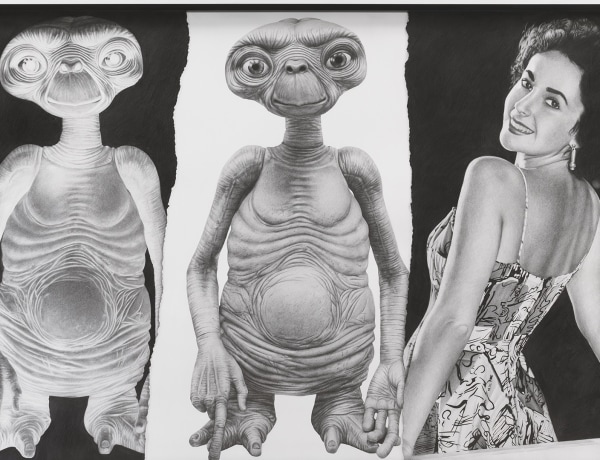
Karl Haendel is included in the group exhibition Drawn Together Again at The Flag Art Foundation in New York.
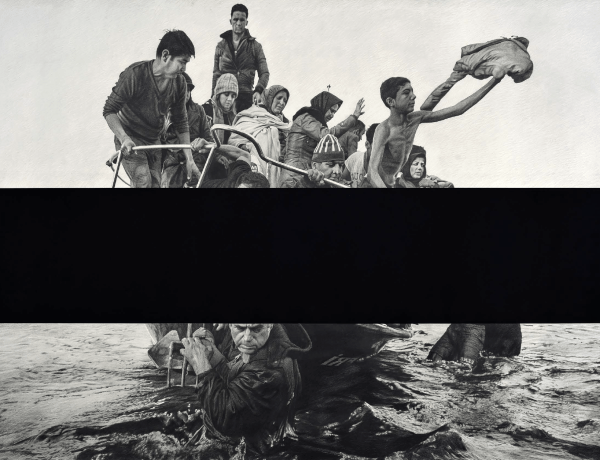
Karl Haendel is included in the group exhibition, The World on Paper, showcasing the Deutsche Bank Collection at the PalaisPopulaire, Berlin.

Karl Haendel & Martha Rosler are included in The American Dream: American Realism 1945-2017, an exhibition installed across two museums, Drents Museum and Kunsthalle Emden. Both artists' works will be on display in Emden.
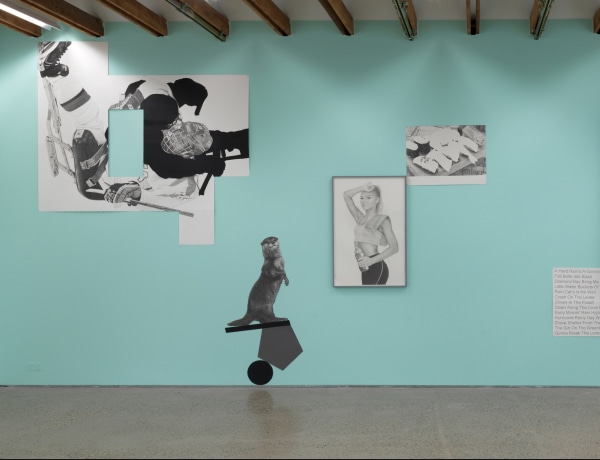
Karl Haendel is included in Kunstvereniging's group exhibition I who make mistakes on the eternal typewriter, curated by Marcel van Eeden and Nanette Kraaikamp.
A conversation between artist Karl Haendel and Leah Levy, director of The Jay DeFeo Foundation, moderated by Claire Gilman, chief curator of The Drawing Center, on the occasion of Karl Haendel & Jay DeFeo: Pink Cup and The Facts at Mitchell-Innes & Nash, NY.
Karl Haendel is included in Kunsthalle Bielefeld's exhibition, Unsere Amerikaner (Our Americans).
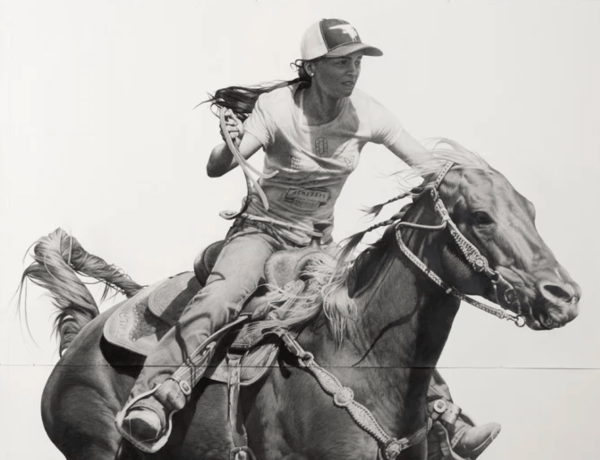
LAxART is pleased to present a collaborative exhibition by Karl Haendel and Tony Lewis. This exhibition developed out of conversations around the possibilities of drawing as a personal, material, and metaphoric practice, an ongoing dialogue largely began when Lewis was Haendel’s student at the School of the Art Institute of Chicago. Since that time, the artists have continued an exchange around their respective approaches to drawing and this exhibition marks the first time such dialogues have been made public. The selected works reflect a shared interest in figuration, social conduct, familial relations, the efficacy of communication, and drawing as a personal and idiosyncratic language.
The 2015 Biennial of the Americas, kicking off July 14 and continuing through August 30, today announces additional inspiring and innovative public programs and partnerships with featured local and international institutions. Hosted in Denver, the Biennial of the Americas is an international festival of ideas, art and culture. The most inspiring artists, innovators and experts will explore the theme “NOW!,” examining today’s exceptional times in the Western Hemisphere.
The Biennial of the Americas connects business, art, culture and civic leaders from throughout the Americas by building lasting relationships, addressing shared issues and inspiring action.
Never before has the fall season for the Castello di Rivoli been so full of events and important exhibitions. Among these is one of the most comprehensive the Museum has ever conceived, installed in both the spacious Manica Lunga and in the third-floor rooms of the Sabauda Residence. The event – Manifest Intention. Drawing In All Its Forms – focuses on drawing in its various forms and many modes of expression: from everyday and self-controlled practice to elements of analysis and creative outlets, from a means of communication to the need to express. The absolute protagonist of the exhibition, drawing also proposes a broader reflection on themes that over time have shaped the very concept of a museum and a collection, analyzing the medium’s context both as a sign of the work and as the work itself. Drawing, oftentimes hidden or kept in the shadows, is actually the common ground of artistic practice – be it a sketch, a project, or even a work that is finished and laden with messages.
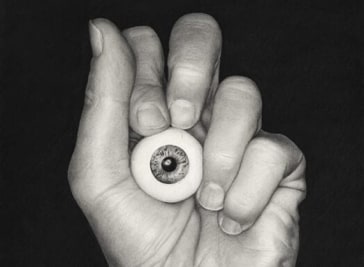
Glasstire counts down the top five art events in Texas. Number 4: Karl Haendel at Lora Reynolds Gallery, from March 30 - June 1, 2024. Lora Reynolds is pleased to announce Love and Capital, an exhibition of graphite drawings (that sometimes include ink) by Karl Haendel — the artist’s first show at the gallery. Haendel’s drawings—sometimes modestly scaled, often gigantic, installed unconventionally (high, low, salon style and solo, across corners, snaking onto the ceiling) — are mostly rendered in a striking photorealistic style. They play with a wide range of imagery: from medieval suits of armor, big cats and dead bees, human hands, oversized scribbles, introspective and deeply vulnerable texts, embodied punctuation, portraits of famous politicians, barrel-racing girls on horseback, all manner of cartoons, to aerial views of flooded neighborhoods and the rotunda at the Texas State Capitol.
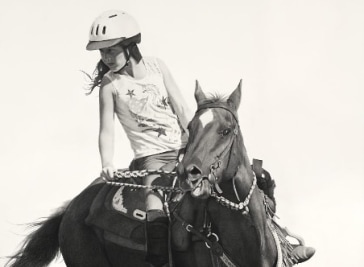
Hold onto your cowboy hats. This is no ordinary Western art show. The simply titled “Cowboy” opens at the Museum of Contemporary Art Denver on September 29 and it’s sure to garner major attention in the Western U.S. and beyond. The show, organized by curators Nora Burnett Abrams and Miranda Lash, takes aim at the mythic figure, which they describe as “one of the most fraught and persistent figures in contemporary American culture.” The show raises questions such as how the myth of the cowboy exists today and how this archetype of masculinity shaped how we think about gender now. It further delves into cowboys’ relationship to the land through a series of broad perspectives and aims to debunk the homogenous concept of the cowboy as a white male. “There is no mythic figure who is more grand and complicated than the cowboy,” said Burnett Abrams in a phone interview. Originally, she said, she was looking into the history of the Black cowboy, but over the course of years of conversations, the concept was broadened.
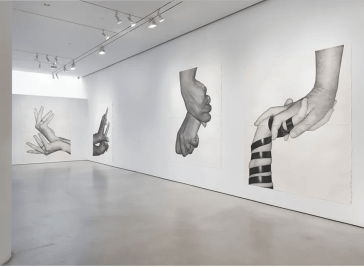
In New York City, hand gestures speak much. They talk about our ethnicity and our gods. “Praise New York,” an exhibit of Karl Haendel’s large-scale drawings of the religious hands of our city, is taking place from March 10th to April 16th in Chelsea, Manhattan at Mitchell-Innes & Nash Gallery, 534 West 26th Street, open Tuesday through Saturday, 10 AM to 6 PM. The artist Haendel explores the world with his own hands by drawing portraits of other people through a close look at their hands. The drawings are larger than a human being is tall which in the gallery creates the feeling of hands as living fashion models standing in poises of praise and offerings of grace. He says, “It’s a novel way to make a portrait, allowing people to express themselves with gesture and nuance” using hands rather than faces, which moves too quickly in our day and age to invoke standards of beauty rather than portraits of the soul.
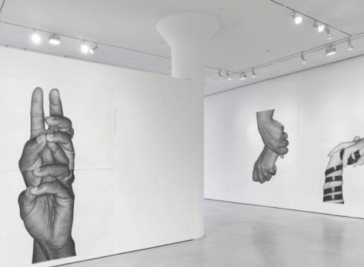
Haendel’s nearly nine-feet tall, wow-inspiring realist depictions of the hands of some of New York City’s Muslim, Buddhist, Hindu, Jewish, Christian and Sikh faith leaders on exhibition at the Mitchell-Innes & Nash gallery in West Chelsea, is certainly a fresh way to create a group portrait. On view until April 16, “Praise New York” honors a diverse group of pastors, imams, rabbis and priests who helped New Yorkers cope throughout the worst days of the pandemic.
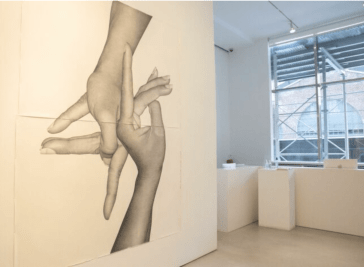
Big Apple native Karl Haendel's "Praise New York" exhibition, inauguarted Thursday at the Mitchell-Innes & Nash art gallery in the West Side Manhattan neighborhood of Chelsea and scheduled to run through April 16, pays homage to rabbis, priests, imams, pastors and other faith leaders who have shared vital resources and boosted the city's morale over the past two years.
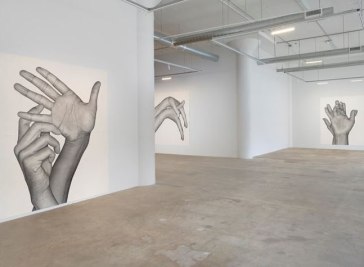
Twenty-four monumental drawings of exquisite detail will be divided into two exhibitions at Vielmetter Los Angeles, with the second chapter of Karl Haendel's presentation opening on 15 February 2020. Each drawing captures the intimate interlocking of hands, between Haendel and his ex-wife—an alternative to portraiture that he expresses as having a powerful, 'embodied sculptural presence', which he eventually expanded to include the hands of his friends.
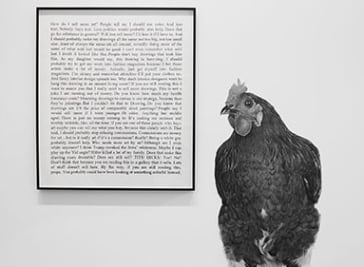
Nothing pulls you into a gallery like a six-foot chicken giving you the side eye, nor keeps you in front of a work longer than giving you something to do, even if it’s just reading text. With these two strategies Karl Haendel introduces Masses and Mainstream, not with a curatorial hang that pulls you into the center of a space and lets you wander, but by arresting the viewer at the entrance. There is a compulsion to use the works there as a lens through which to see and interpret the rest of the exhibition. How Do I Sell More Art pairs with Chicken within direct line of sight from the door and the two are impossible to ignore, melding into a single piece: A framed text piece operates like a word-bubble in such close proximity to the terrifying and terrified giant chicken, in graphite on cut paper stuck to the wall from the floor up.
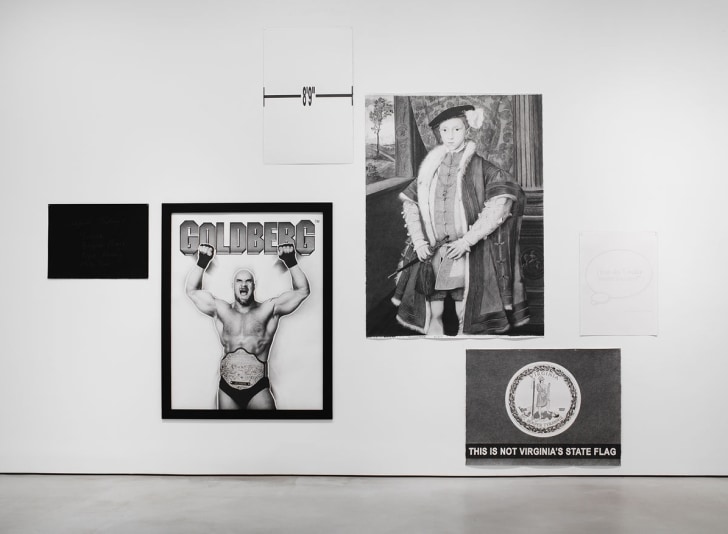
It takes a lot of chutzpah to be an artist, to labor over something in the privacy of your own studio and then unveil it to the world, expecting total strangers to pay attention—and maybe even love, purchase, and live with what you’ve created. While artists may talk fondly of the glories of failure—its unexpected silver linings, its teachable moments—they’re not too good at publicly expressing vulnerability and doubt. After all, success in the art world can often come down to how convincing and memorable one’s personal brand is; I’m Not Sure If This Is Actually Any Good™ doesn’t make for the most rousing slogan.

A good conceptual art piece is not very different from a joke, and Karl Haendel’s got a million of ’em. His show “Masses & Mainstream,” at Mitchell-Innes & Nash, is a torrent of pencil drawings large and small, and all of them revolve, in one way or another, around the artist’s ability to make anything in the world into a kind of punch line merely by pointing it out.
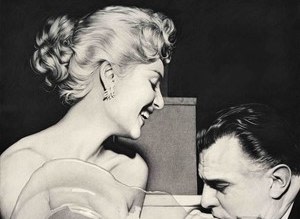
Born in New York in 1976, Karl Haendel currently lives and works in Los Angeles. He is known for creating meticulous, photorealistic pencil drawings, most of which are based on appropriated photographs. Haendel often works on a large scale, removing the images from their original context and playing with our relationship to familiar images, signs and signifiers.
Haendel’s work is in public collections in the Los Angeles Museum of Contemporary Art, The Museum of Modern Art, New York and the Guggenheim Museum, New York.
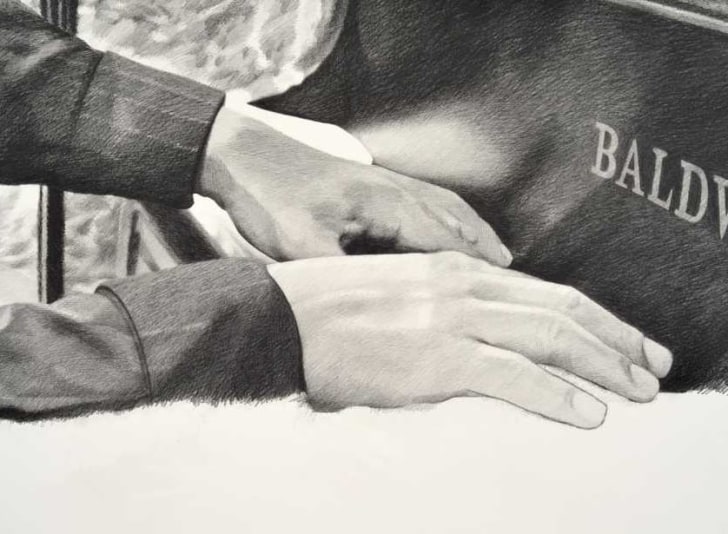
This will be the gallery’s second exhibition of these artists and the first time the two will be exhibited together. The exhibition showcases the relation between the works of the artists which are based on the process of making drawings.
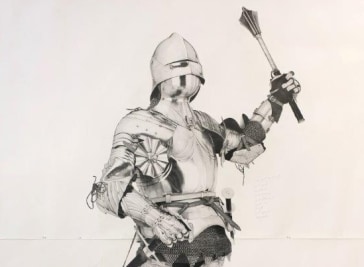
Since the rise of appropriation in American art of the 1980s, the strategy has become so commonplace as to evade continued examination as a unique vein of artistic practice. At the same time, recurrent intellectual property battles around appropriative gestures in contemporary art have threatened its viability, giving rise to College Art Association’s important report published in February 2015, the Code of Best Practices in Fair Use for the Visual Arts. This three-part essay on the work of Karl Haendel, an LA-based artist best known for his arrangements of meticulously rendered drawings of found photographic imagery, connects three moments in his early career related to issues of artistic and cultural heritage and power. The first two episodes directly involve knights. Taking Haendel’s work as a point of departure and considering the digital turn, the essay as a whole examines how the operations, effects, and reception of appropriation have changed in recent decades and discovers what may be the strategy’s longest-lasting politics of signification. “Episode One” considered Haendel’s early project of reconstructing works by the minimalist sculptor Anne Truitt, including Knight’s Heritage (1963). This second text examines Haendel’s confrontation with another artist of an older generation, the early postmodernist Robert Longo.
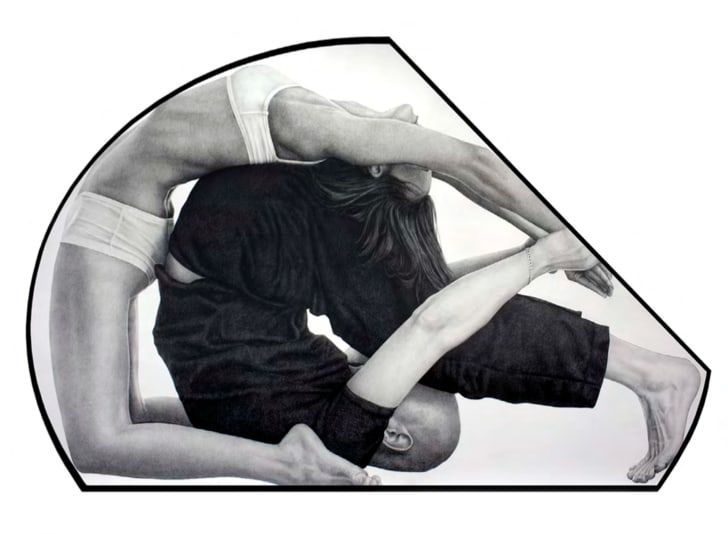
Karl Haendel’s exhibition posits the practice of yoga as an alternative to accelerationism. Citing the anxiety around self-optimization, Haendel presents lifestyle- and body-enhancement products marketed to reinforce the need for self-betterment to question the ways these objects aid or inhibit our sense of self-worth and identity.
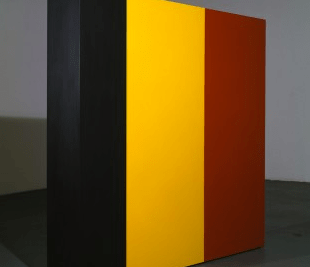
Since the rise of appropriation in American art of the 1980s, the strategy has become so commonplace as to evade continued examination as a unique vein of artistic practice. At the same time, recurrent intellectual property battles around appropriative gestures in contemporary art have threatened its viability, giving rise to CAA’s important report published in February 2015, the Code of Best Practices in Fair Use for the Visual Arts. This three-part essay on the work of Karl Haendel, an LA-based artist best known for his arrangements of meticulously rendered drawings of found photographic imagery, connects three moments in his early career related to issues of artistic and cultural heritage and power. The first two episodes directly involve knights. Taking Haendel’s work as a point of departure and considering the digital turn, the essay examines how the operations, effects, and reception of appropriation have changed in recent decades and discovers what may be the strategy’s longest-lasting politics of signification.
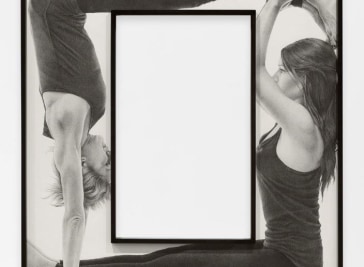
Los Angeles-based artist Karl Haendel, born in 1976, is part of
a generational cohort that breathed new life into 1980s appropriationist
strategies in various mediums. His Photo-Realist
draftsmanship recalls the technique of fellow Californian Andrea
Bowers, while his eye-catching installations evince a showmanship
shared by artists like Kelley Walker. Unlike Bowers, however,
whose labor-intensive drawings pay faithful homage to her source
images (of political protest and leftist movements), Haendel
portrays a more ambivalent attitude toward his hand-drawn reproductions
of mass-media and personal images. “Organic Bedfellow,
Feral Othello,” Haendel’s first solo show at Mitchell-Innes &
Nash, focused on human resistance to “devolution,” per the press
materials. But the works on their own evoked a richer set of
associations toward Haendel’s subjects—modernism, intimacy and
technology—than the exhibition’s rhetorical and visual scaffolding
would suggest.
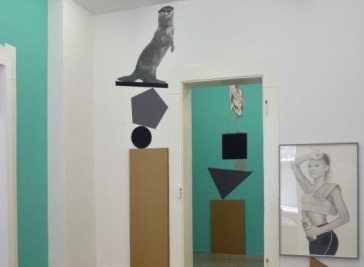
Looking at images in Karl Haendel's exhibition Weeks in Wet Sheets, one might imagine stepping into a virtual space -- give the basic shapes cut out of cardboard that fill up the walls, the works' bright monochrome backgrounds and, not least, the impressive definition of Haendel's large-scale, photo-realist black-and-white pencil drawings-- but it's not like that. In reality you feel cardboard crumpling underneath your feet, see uneven pencil hatching within the works and notice cut edges of paper. The installtion is still awe-inspiring in its immersiveness, but while producing disjunctions between varying economies of speed, value and attention.

The Los Angeles-based artist fills the space with intricate graphite drawings, in shaped frames, depicting both humans (engaged in various, partner-yoga-style contortions) and primates (often balancing quizzically atop stacks of Constructivist shapes). Tabletop arrangements flaunt additional drawings of health-and-beauty and self-improvement products (like Rembrandt tooth-whitening strips), along with hand-sketched QR codes that, when activated, lead to inspirational online videos “chronicling physical transformation.” The overall effect is of a delightful too-muchness, of strange links being forged between very disparate things — just what one might expect from an exhibition tongue-twistingly titled “Organic Bedfellow, Feral Othello.”
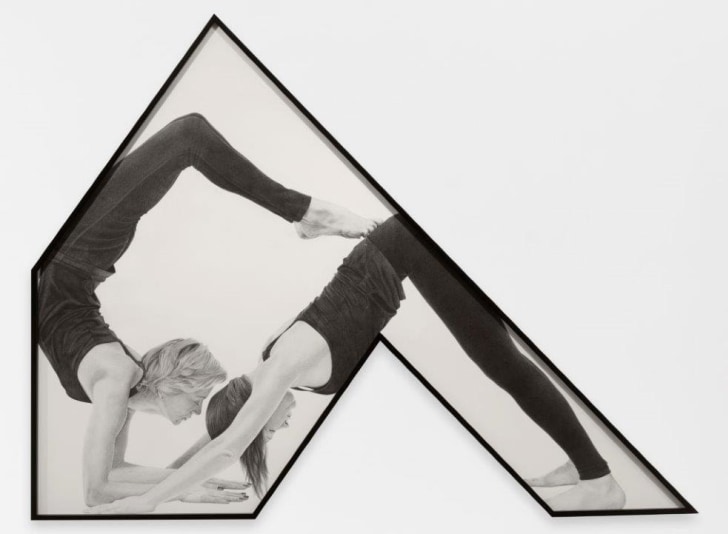
The exhibit, Organic Bedfellow, Feral Othello, features the photorealistic graphic drawings of Los Angeles-based artist Karl Haendel. But the show is as much about the art as it is about the immersive installation space. Black-and-white checked patterns bisect the gallery floor and the artist's still-life drawings of primates balancing on geometric stacks and couples contorting in yoga poses are propped on polygonal stands with hand-drawn QR codes. The codes link to YouTube videos that chronicle suchs physical transformation as weight-loss journey or gender transition. The exhibit is on show at Mitchell-Innes & Nash's Chelsea gallery until Dec. 5.
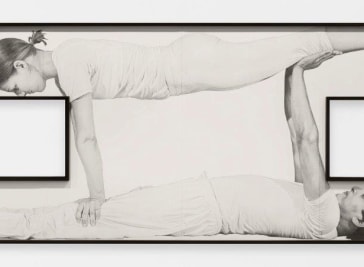
Is our evolution our devolution? Or better yet – is our devolution our evolution? According to Karl Haendel, it’s both these things, as we can witness too by exploring his latest exhibition entitled Organic Bedfellow, Feral Othello, to be hosted by New York’s Mitchell-Innes & Nash. Through large, masterfully executed drawings set within a monochromatic installation, the Los Angeles-based artist takes humanity back to its roots, in order to better understand its development through time, keeping in touch with the present at the same time.
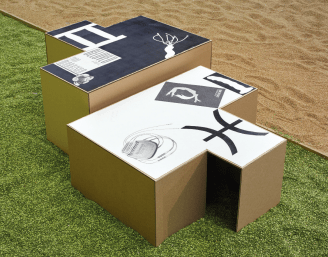
Unpacking the exhibition's title gives clues to deeper meanings. Without the "un" there are boxes, bends, cocks and wind. The use of "un" features letters of the same shape, bent in opposite directions, signs for the yin/yang, push/pull--dialectal relationships within the exhibition. Haendel creates a narrative that weaves through the disparate groupings and can be read in any sequence. While the exact nature of the narrative remains ambiguous, it is sifted through the lens of astrology, yoga poses and the interconnectedness of mind and body. The result is an evocative and challenging installation, comprised of individual elements whose meaning when seen in relation to each other is simultaneously finite and open-ended.
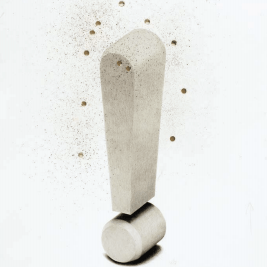
Karl Haendel engages the long process of language building. His exacting drawings are the idioms that he deploys to assemble his syntactical, room-filling installations and architectural display conceits. The result is a gathering of hand-drawn images that when selectively juxtaposed with each other form a visual analogy that is similar to literary enterprises. For example, clusters of varied graphite-wrought images suggest humorous self-deprecating free verse or complex prose punctuated with neologisms, metaphors and popular signs. More simply, Haendel uses his drawings as words and punctuation, referring to each drawing in his visual vocabulary as a 'concept/image/word'.
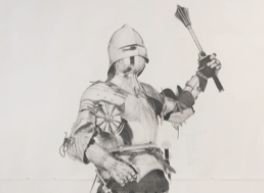
A recent exhibition at Susanne Vielmetter, through a narror corridor flanked by two identical portraits of J.Edgar Hoover. Between the Hoovers (whose heads have been erased) is a spare wooden tabletop furnished with four copies of a small black book called Shame, a compilation of anonymous confessions culled from Internet chat-boards. Ranging in subject matter from pedophilia to rape fantasies to suicide plans, Shame reads as an oddly meditative expose. Installed throughout are the large-scale graphite works on paper for which Haendel is best known. Presently scenarios such as American football players on the Monday- night field and giant military jackets, Haendel's delicate and studied brand of photorealism combines the precision of a Robert Bechtel with the mystery of a Vija Celmins.
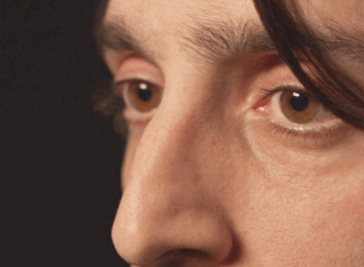
Criticism, as they say, is autobiography, and I can freely admit that I may Karl Haendel’s soon-to-close show at Harris Lieberman moving because I'm close to the demographic it addresses. The video installation is about men in their 30s; I'm 32. Haendel, for his part, was born in 1976, and "Questions for My Father," as the work is called, feels personal, a kind of oblique interrogation of what that particular moment in one's life means and feels like.
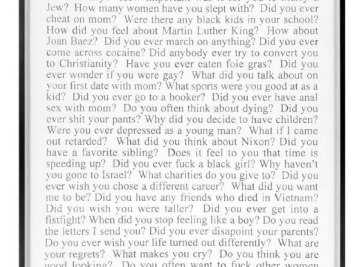
"Questions for My Father" evolved from a series of large graphite word-drawings of the same title that Mr. Haendel, working in an anonymous commercial-art style, directed at his own father. Here he extends the fromula to friends with questions of their own, creating a kind of abstract documentary that expands in the viewer's mind. The work continues the resonating image-caption hybrid introduced by Conceptual Art.
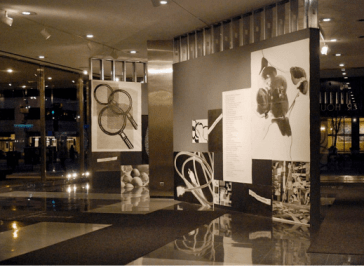
Lever House, the glassy green box and ur-skyscraper of New York architectural Modernism that Skidmore, Owings and Merrill erected on Park Avenue in 1951, has also been the site of some of the city's more interesting contemporary art installations of late. Since 2003, Aby Rosen and Alberto Mugrabi have commissioned artists including Damien Hirst, Jeff Koons, and Sarah Morris to make new works for the Lever House Art Collection. This past week, the latest commissioned artist, Los Angeles-based Karl Haendel, mounted an installation of his signature, stunning graphite drawings on paper—one series depicting cracked light bulbs, mirrors, and eggs; another, the fortunes from fortune cookies; another, abstractions that riff on Mondrian's "Boogie-Woogie" series—all of which cover two 20-foot-long walls that cross the building's famed glass lobby.
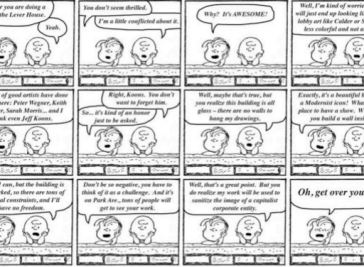
The Lever House is a glass box, and glass boxes don't really do very well with two-dimensional art. There's an obvious reason: no walls to hang work on. Other artists who have had exhibitions here have build walls at predicable locations inside the lobby, but I thought that that would feel too stale and normallized. I wanted the space to activate my work, but I also had to keep in mind that these are drawings; the medium itself has conditions that must be met.
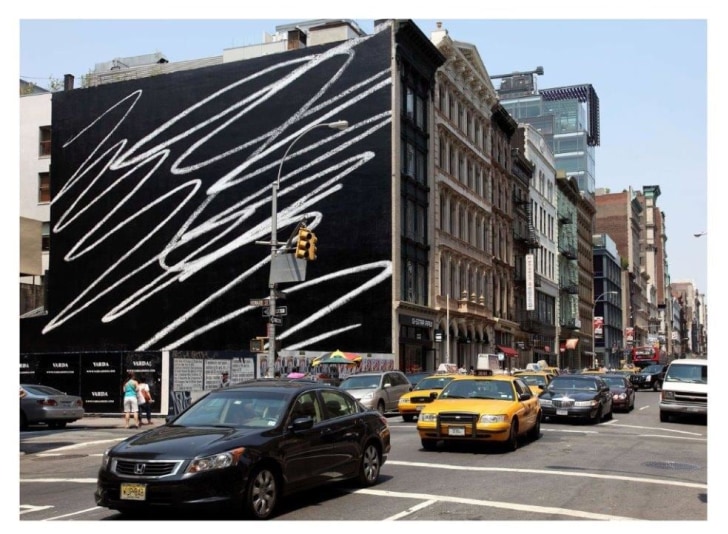
It started with a simple doodle, the kind we all make while talking on the telephone of watching television.
But for Karl Haendel, a 32-year-old artist in Los Angeles, these haphazard scribbles were the beginning of something else. "I wondered what would happen were I to blow one of them up really big," he said in a telephone interview from his studio."That's when I realized they were the seeds of large abstractions."
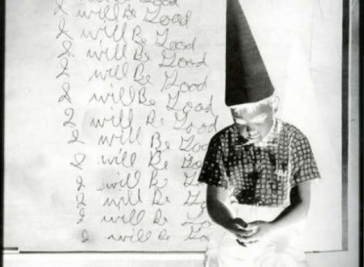
Karl Haendel makes monochromatic graphic drawings and istallations based on preexisting photographic images from family albums, front-page political news, and rock iconography. He renders his ghostly, meticulously crafted graphite drawings with radical shifts in scale and then installs them salon-style so that they constantly refer to one another.
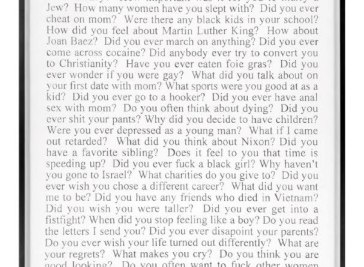
Private thoughts and public images are rendered starkly in black and white in Karl Haendel's first New York solo appearance. Three photographs and forty-six labor-intensive, mostly large-scale drawings, depicting everything from Kenneth Noland-esque concentric circles to headlines clipped from the New York Times to iconic photojournalistic images, were arrayed around the gallery walls in a way that verged at times on the ludic (as with one work consisting of the repeated phrase BUSH, PLEASE BUY RUBBERS) and at times on the melancholy (as with elegiac renderings of moments from Haendel's '70s childhood) but that, due to the artist's pixel-perfect style, felt wryly restrained. Indeed, the works evinced a staggering fidelity to their source images, which the artist, with the help of assistants, often uses projections to produce.

In his first New York solo, the young Los Angeles artist Karl Haendel makes good on his promising group show appearances. He gives free rein to his keen understanding of graphic power, visual scale and the play between mechanical and handmade reproduction. He also makes clear how public and private experiences are inseparable.
